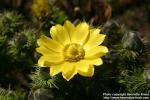
 The whole plant of Adonis vernalis, Linné.
The whole plant of Adonis vernalis, Linné.
Nat. Ord.—Ranunculaceae.
COMMON NAMES.—Pheasant's eye, False hellebore.
Botanical Source.—Adonis is a perennial herb growing from 12 to 15 inches high. The stem is branching, and the leaves many-cleft and sessile. The flowers are large, yellow, and attractive, with 10 or 12 oblong, spreading petals, slightly toothed at the apex. The fruit consists of numerous 1-sided acheniae.
History and Chemical Composition.—This plant is indigenous to Southern Europe (being especially found in the Crimea) and to Siberia and Labrador. It is one of the very reliable spring flowers, and is found growing in elevated places. It was introduced into medicine by Dr. Bubnow (1879) as a cardiac stimulant. The doctor, who was a student under Prof. Botken, had observed its use by the Russian peasantry as a remedy for dropsy and heart diseases. Linderos (1876) obtained a yellow crystalline substance from the leaves and identified it as aconitic acid (C6H6O6). In 1882, Prof. V. Cervello isolated its supposed active principle, which he named adonidine (adonidin). Adonidin is a crystalline, non-nitrogenous glucosid, odorless, colorless, and intensely bitter. Ether slightly dissolves it, while it is wholly soluble in alcohol and water. It is practically insoluble in benzol, chloroform, and turpentine. According to Podwissotzky, who has more recently (1888) investigated it, adonidin is a mixture composed of adonitic acid, adonidoquercitrin, adonidodulcit, and a couple of glucosids, one of which is the active constituent and named by him picradonidin. It is a very bitter, amorphous body, dissolving in alcohol, ether, and water, and said to be a powerful cardiac poison. Tannin precipitates adonidin from aqueous or ethereal solutions. Adonis root is frequently employed to adulterate black hellebore (Helleborus niger).
Action, Medical Uses, and Dosage.—Adonis acts very much like digitalis and strophanthus. It stimulates the muscles of the heart, thereby increasing cardiac contractility, and causes contraction of the smaller arteries throughout the whole body, thus increasing arterial tension. It diminishes the frequency of the pulse and regulates the heart-beat. The remedy acts quickly, even quicker than digitalis, and is well tolerated. Diuresis is increased, probably by its action on the renal circulation. Large doses paralyze both the heart and blood-vessels. Unlike digitalis, it is not cumulative. The drug should be cautiously used where there is gastro-intestinal inflammation. Adonidin in 3-grain doses every half hour, administered by mistake, produced violent vomiting and purging (Durand). Homoeopathic physicians speak highly of this drug in heart disease, and kidney affections. Prof. E. M. Hale recommends its use in endocardial inflammation, with valvulitis. It is adapted to those cases where the cardiac muscles are laboring to overcome valvular obstruction, or when there is danger of dilatation of the heart from weakening of the muscular tissues. Prof. Hale also intimates that it is valuable in secondary heart trouble, resulting from Bright's disease, being indicated by an irregular and intermitting pulse, showing weakened heart action, with venous stasis and dropsy. It is valuable in cardiac dropsy. Rx Specific adonis, gtt. ij, every 2 or 4 hours. In chronic albuminuria, with scanty, light-colored urine and delirium, 5-drop doses greatly benefited the patient, and in another case it controlled uremic convulsions, which had been frequent, so that they did not again appear for two years, when the patient died (Wilcox). Prof. John M. Scudder said of it: "Its tonic action upon the heart is most marked." He recommended its use in heart strain from over-exertion. In one case its beneficial action was observed in one day. The remedy bids fair to take its place alongside of other drugs of the digitalis group in the treatment of all cases in which the latter are now so highly valued. Pallas attributes to the plant emmenagogue properties. The dose of the infusion (ʒj to aqua ℥xij) is a tablespoonful every 2 hours in severe cases; every 4 hours in chronic disease. Specific adonis, ½ to 3 drops. Or, Rx Specific adonis gtt. x to xx, water ℥iv. Mix. Dose, 1 teaspoonful every 2 or 3 hours.
Adonidin, 3/10 grain every 3 or 4 hours.
Specific Indications and Uses.—As a heart tonic, to be used when cardiac action is weak, with but little blood in the arterial system, with low pressure and shortened diastole, and consequent venous fullness and stasis with increased pressure, feeble, irregular, and intermittent pulse; valvular insufficiency, with regurgitation, and dropsy; vascular enfeeblement with passive, dull, congestive headache; chronic congestion.
Related Species.—Adonis aestivalis, Linné. Europe and Asia. An almost glabrous annual, having a bitter, acrid taste, but scarcely any odor. Its blossoms are of a yellowish-red hue. A remedy for fatty heart.
Adonis autumnalis, Linné. South Europe. Resembles the preceding in properties and appearance, except that it bears crimson blossom. Both plants have the action and constituents of Adonis vernalis.

